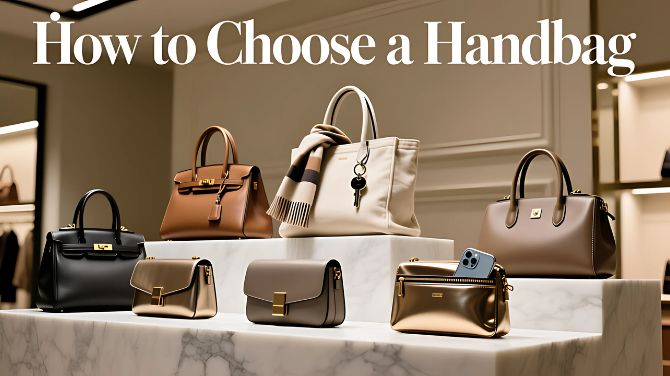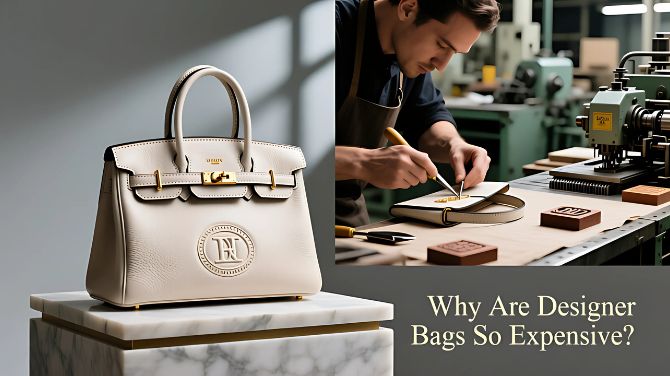Buying a handbag can feel like picking a new friend. Will it go everywhere with you? Will it carry your stuff without breaking? Or will it look great in pictures but flop in real life? If you have ever stood in a store holding two bags and thought, “Which one?” this guide on how to choose a handbag is for you.
I have had bags that stayed in my closet for years and others that outlived relationships. So I have bought expensive ones and cheap ones. I have loved some at first sight and others only after I learned their secrets. Bags are more than accessories. They carry your life and sometimes even your mood.
By the end of this guide on how to choose a handbag, you will know how to pick a bag that fits your life, your style, and your daily needs. You will also know what materials, features, and details are worth spending on. This is not just about fashion. It is about making your life easier and keeping your essentials safe.
How to Choose A Handbag?
Picking a handbag can feel like choosing a new best friend. Will it carry your life, keep up with your days, and still look great? Let’s find the one that actually works for you.
Start with Purpose: The First Question that Matters

Ask yourself: What will this bag really do for me?
Write it down if you have to. Most people skip this and later wonder why their bag never gets used. Knowing the purpose first will save you money and stress.
Think about your daily life:
- Work bag: Laptop, notebook, lunch, charger, keys, wallet. Maybe a small planner.
- Weekend bag: Phone, wallet, camera, water bottle, sweater, maybe a book.
- Evening bag: Phone, small wallet, keys, lipstick, cardholder.
- Travel bag: Passport, tickets, wallet, sunglasses, headphones, snacks.
- Parent bag: Snacks, wipes, water bottles, toys, keys, phone, wallet.
Different purposes need different sizes and shapes. Do not buy a tiny bag for work if you carry a laptop. You will regret it by Tuesday. I have done that myself. A bag that cannot hold your essentials is useless.
Be honest. Will you really carry this bag every day, or is it just for Instagram? Answering this narrows your options quickly.
Mini story: I once bought a beautiful tote for daily use. It looked perfect but was too small for my laptop. It ended up mostly in my closet while I carried my old backpack to work. Purpose matters first.
Size And Shape: Practical Matters
Size is everything. Too small and it is useless. Too big and items get lost. Shape affects usability, comfort, and organization.

Common shapes
- Tote: Big and open. Great for work, errands, or shopping. Can hold laptops, notebooks, lunch, and a jacket. Downsides: things get lost at the bottom.
- Shoulder bag: Medium, often slouchy. Comfortable for daily use. Can be casual or professional. Be careful not to overload it.
- Crossbody: Hands-free, secure, great for travel or crowded places. Small crossbody holds essentials, bigger ones can hold tablets or travel items.
- Satchel: Structured and office-friendly. Often has compartments and a handle. Looks smart but can be tricky to pack casually.
- Clutch: Small, elegant, for evenings or minimalists. Perfect for essentials but not for work or travel.
Tip: Measure your items before buying. Laptops, tablets, and water bottles need space. Bags listed as “fits a 13-inch laptop” are not all the same.
Mini story: I bought a trendy tote that looked perfect online. Reality: it could not fit my lunchbox. It became a “fashion bag” I rarely used. Size matters. Always think practically.
Pro tip: If you carry extra items like water bottles, reusable bags, or snacks, factor that in. The bag should hold everything without straining seams.
Material Matters: Leather, Faux, Fabric, And New Options
Material affects look, feel, weight, durability, and care. It also affects comfort and how the bag moves with you.

Leather
- Pros: Ages beautifully, strong, classic.
- Cons: Expensive, needs care, can scratch.
Types
- Full-grain leather: Very durable, develops a patina.
- Top-grain leather: Smoother, cheaper, can show scratches.
- Genuine leather: Lower grade, less durable, sometimes coated.
Faux leather / vegan leather
- Pros: Animal-friendly, cheaper, lighter, easy care.
- Cons: Low-quality versions peel over time. Plant-based options are durable and eco-friendly.
Fabric (canvas, nylon, cordura)
- Pros: Lightweight, washable, casual.
- Cons: Can stain, may look cheap, less structured.
Hardware and lining
- Zippers should glide smoothly.
- Clasps and metal fittings should feel solid.
- Linings protect the bag and reinforce stress points.
Mini story: I once bought a cheap faux leather tote. Six months later it was peeling. A good quality bag feels solid and smooth. You can tell before you even fill it.
Pro tip: Press leather lightly. It should feel soft and natural, not plastic. Check fabric weaving and stitching on fabric bags.
Construction And Quality: What to Check
Look past logos. Touch it. Shake it. Check seams. A bag is only as strong as its stitching and materials.

In-store tests
- Stitching: Even, no loose threads. Reinforced at stress points.
- Lining: Properly attached and neat.
- Zippers: Glide smoothly. Open and close several times.
- Straps: Securely attached. Gently pull to test.
- Hardware: Solid, not hollow.
- Edges: Finished edges last longer; raw edges fray.
Online tips
- Zoom photos for seams, corners, and hardware.
- Read reviews on durability, not just style.
Mini story: I bought a designer bag online. It looked perfect, but the stitching was uneven and a strap was loose. I returned it. Checking details saves money and headaches.
Pro tip: Test with items similar in weight to your daily essentials. Check how it feels when full. Does it sag or strain?
Organization: Pockets Matter
Do you like everything organized or just throw things in? Organization matters.

Pocket checklist
- Phone pocket: Quick access and protection.
- Zippered pocket: For cash and IDs.
- Main compartment: Wide and open.
- Divider: Keeps things from mixing.
- Key clip: Saves time digging for keys.
Mini story: My old bag had no compartments. Finding keys took ten minutes. A bag with even one zip pocket improved my mornings instantly.
Pro tip: Some bags have removable inserts. Great for switching between organized or free space.
Comfort: It Sits on Your Body
Try it on. Walk around. Lift and swing it. Comfort is key.

Consider
- Strap length: Should hang naturally.
- Weight: Leather and hardware add pounds.
- Crossbody: Distributes weight evenly.
- Padding: Helps when carrying heavy items.
Mini story: I have a weak left shoulder. Crossbody and wide straps saved me from aches. Small comfort features matter more than you think.
Extra tip: Walk for 5–10 minutes in the store. Does it rub or slide?
Must Check: PU Leather vs Faux Leather
Color And Style: Match Life, Not Just Outfits

Neutral colors last longer. Bold colors make statements.
- Neutral: Black, brown, tan, navy. Matches almost everything.
- Seasonal: Olive, mustard, berry. Fun but limited.
- Patterned: High risk, low resale value.
Check trims, stitching, and hardware color. Gold goes with warm browns, silver with black or grey.
Mini story: I bought a pastel bag because it was trendy. Rarely used it because it clashed with most outfits. Neutrals win for long-term use.
Pro tip: Consider versatile colors like muted blue or olive. Works in casual and semi-formal settings.
Price, Brand, And Value: What to Spend on?
Price is part of the story. Look at materials, durability, and expected life.

When to splurge
- Daily work bag meant to last years
- Bags that can be repaired
- Timeless designs with resale potential
When to save
- Trendy seasonal bags
- Styles you are unsure about
- Travel bags exposed to damage
Mini story: A mid-range leather bag I bought lasted six years. An expensive designer bag wore out in two. Price alone does not guarantee quality.
Pro tip: Look for brands that offer repairs. A fixed strap or replaced zipper extends life.
Ethical and Environmental Choices

Want to help the planet? Here’s how:
- Good Leather: Choose leather that’s made responsibly.
- Honest Brands: Go for brands that share how they make things.
- Plant or Recycled Materials: Pick items made from plants or recycled stuff.
- Repair or Return: Some brands let you send back old things to be fixed.
- Vegan Leather: Make sure it’s made from plants, not plastic.
- Recycled Leather: Some brands use old leather to make new things.
- Check Labels: Look for eco-friendly labels like Fair Trade.
Mini Story:
I needed a new bag and found one made from plants. It’s light, durable, and good for the planet. Now, it’s my favorite weekend bag.Vegan leather is not always eco-friendly. PVC is harmful. Bio-based leather is better. Always check claims.
Care And Maintenance
Taking care of your bag helps it last longer. Here’s how:

- Clean Spills Right Away: Blot the spill, don’t rub.
- Use Leather Conditioner: Only a little, no need to overdo it.
- Store Properly: Keep in a dust bag or pillowcase, and stuff to keep its shape.
- Don’t Overload: Be gentle with how much you pack.
- Fabric Bags: Let them air dry, no heat.
Mini Story:
A friend ruined her canvas bag by leaving a wet bottle inside overnight. Small habits like cleaning up spills or storing your bag properly can prevent big problems.
Travel And Security
Travel safe, stay smart. Protect yourself and your stuff wherever you go.
For travel

- Crossbody for safety: Keeps your bag close and secure, especially in crowds.
- Hidden pockets: Perfect for your passport and cash, keeping them out of sight.
- RFID pockets: Protects your cards from being scanned by thieves.
- Convertible straps: Switch from a daytime bag to a night-out style in seconds.
Travel Tip: Go for water-resistant, lightweight bags with secure closures to keep everything safe and dry.
Mini Story:
I once carried an open tote in a busy market, and I kept worrying about pickpockets. A zippered crossbody would’ve kept my things safe and close. Now, I always choose bags with secure zippers and hidden pockets.
Trend vs Timeless

Mix classics and fun pieces.
Classic: Structured tote, neutral crossbody, evening clutch.
Trendy: Bold mini bags, baguettes, statement hardware.
Classics last longer. Trendy items keep it fun.
Budget-Friendly Tips
You do not need to spend a ton to find a bag that actually works for you. Here are some tips I have picked up over the years:

Mid-market brands can surprise you
I once bought a bag from a mid-range brand and it lasted years. Quality does not always mean expensive.
Go for classic shapes and minimal hardware
Bags with too many details can look dated fast. Simple styles last longer and go with everything.
Keep an eye on off-season sales
Some of my best finds were half price just because I waited a little.
Gently used designer bags are worth a look
You can get a nearly-new luxury bag for a fraction of the price. I scored one online and it still feels like a splurge.
Repair instead of replace
A small zipper fix or strap replacement can give your favorite bag a new life. It is cheaper and often keeps a bag you really love in rotation.
With a bit of patience and some smart choices, you can find a bag that fits your style, lasts long, and does not eat up your budget. It is all about finding what works for you, not just what looks expensive.
Quick Checklist
- Purpose: Matches your life
- Size: Fits your items
- Material: Durable and comfortable
- Construction: Strong stitching, zippers, straps
- Comfort: Feels good on your body
- Organization: Pockets make life easier
- Color: Matches most outfits
- Price: Worth it
- Care: Easy to maintain
- Ethics: Brand aligns with values
Final Thoughts
You will make mistakes. Some bags will become your favorites. Some will sit in your closet, unused. That is okay. Choosing a handbag is about finding one that makes life easier and feels like you.
Mini story: I once bought a tiny crossbody on a whim. I thought it would be just for weekends. It quickly became my daily bag. Light, holds exactly what I need, and makes running errands or meeting friends easier. The right bag quietly fixes little annoyances you did not even notice.
Try a bag on. Walk around with it. Put in your phone, wallet, keys, maybe a small notebook or water bottle. Does it carry everything without feeling heavy or awkward? Does it sit comfortably on your shoulder or across your body? That is the test that matters. The right bag does more than look good. It works for you every day.



